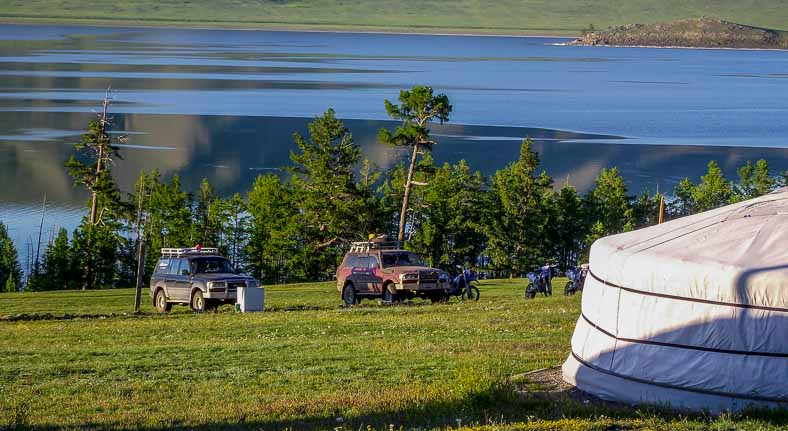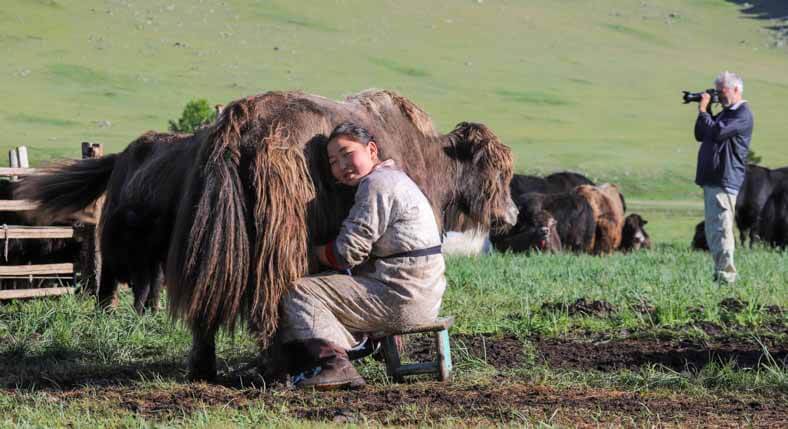Itinerary
Day 1: Arrive in Ulaanbaatar
Welcome to Ulaanbaatar, the capital city that blends traditional Mongolian lifestyles with modern lifestyles. Upon arrival in Mongolia, you will be greeted by an experienced driver and transferred to your hotel.
Accommodation: 3* hotel
Meals: not included

Day 2: Genghis Khan Statue and the Trans-Mongolian Train Journey
Meet your guide and driver at your hotel at 8:30 am. The tour begins with a visit to a 40-meter-tall stainless-steel Genghis Khan Statue, the largest equestrian statue in the world. It is oriented towards the east, symbolizing his birthplace and the direction of the sunrise. Along the way, you will climb Zaisan Hill to see a panoramic view of Ulaanbaatar. The driver will take you to the train station, where you will board the train to Erdenet at 6 pm and take an overnight train journey.
Accommodation: Train
Meals: Breakfast, Lunch, Dinner

Day 3:Travel to Khovsgol Lake, exploring verdant nature in the northern part of Mongolia
You will reach Erdenet town at 7:40 AM. After lunch, embark on a Khovsgol Lake journey in northern Mongolia to enjoy the breathtaking scenery of the second freshest lake in Asia. The lake is the most famous attraction in north Mongolia, suitable for leisure travelers who want to enjoy natural beauty, with optional activities such as hiking, horseback riding, fishing, boating, and kayaking in stunning nature. On the way, you will explore Mongolia's stunning northern landscapes and remote villages.
Accommodation: Ger Camp
Meals: Breakfast, Lunch, Dinner

Day 4: Leisurely day at pristine Khovsgol Lake
You will spend the whole day relaxing, enjoying nature, and refreshing from the previous day's ride. The guide will take you to a hill, where you will see the beautiful lake and its surroundings in bird's eyes. Boating and kayaking are the optional activities at the base of the additional payment.
Accommodation: Ger camp
Meals: Breakfast, Lunch, Dinner

Day 5: Reach the northmost village Tsagaan Nuur
Along the way to the northmost village, we will pass through a breathtaking mountainous landscape of “Ulaan Uul village” that includes the Sayan Mountains, a vast mountain range stretching across the border between Mongolia and Russia. Additionally, we will encounter shamanistic wood piles on a mountain pass, which holds spiritual significance due to the Shamanic and Tengri worship. Our journey will take us through the picturesque Darkhad Valley, renowned for its stunning beauty, crystal-clear rivers, and diverse flora and fauna. In the evening, we will reach the northernmost village, Tsagaan Nuur.
Accommodation: Guest house
Meals: Breakfast, Lunch, Dinner

Day 6: Horse riding adventure to Reindeer herding Tsaatan Tribe/Dukha tribe
The trip will start with a short drive to the edge of the Taiga forest. Then, we will continue on horseback to visit the truly fascinating reindeer herding Tsaatan Tribe, who offers a unique cultural experience, customs, and hospitality. It will be one of the most adventurous 3 days of the entire trip.
Accommodation: Teepee
Meals: Breakfast, Lunch, Dinner

Day 7: Remain with the reindeer herding Tsaatan tribe
This excursion includes staying in a teepee or ” yurts” for two nights amid the Taiga forest. Instead of just visiting representatives of the indigenous ethnic minority of reindeer herders near Khovsgol Lake to demonstrate their way of life while earning some money, you will have the opportunity to encounter a genuine reindeer family living deep in the forest. Observe the reindeer herder’s life, hear stories, and explore the surroundings.
Accommodation: Teepee
Meals: Breakfast, Lunch, Dinner

Day 8: Horseback riding to the Tsagaan Nuur village
Continue on horseback for around 7 hours, then drive to the isolated Tsagaan Nuur village. The village takes its name from the picturesque lake. Tsagaan Nuur is the most remote village where the traditional homes give an authentic look into the unique cultural identity of the region.
Accommodation: Guest house
Meals: Breakfast, Lunch, Dinner

Day 9: Ancient grave site near Delger River
Scenic drive to deer stone site of Great Delger River in northern Mongolia. Deer stone monuments are ancient tangible archaeological heritage sites predominantly found in Mongolia. Deer stones are believed to date back to the Bronze Age, but historians debate their origin. Enjoy the stunning natural beauty of the clear water river Delger and the surrounding grassland.
Accommodation: Ger camp
Meals: Breakfast, Lunch, Dinner

Day 10: Travel to the Great White Lake and Khorgo extinct volcano
We will start the day by driving to Great White Lake, known as Terkhiin Tsagaan Nuur. On the way, you can enjoy views of forested mountains, various summer plants, and large herds of nomads’ animals, such as sheep, horses, and yak herds. In addition, we can stop and examine ancient burial mounds and deer stones and see the Chuluut River, known for its breathtaking scenery. The river flows around 415 km through impressive rocky gorges and lush green, rugged mountains. It was formed by volcanic activity millions of years ago.
Accommodation: Ger camp
Meals: Breakfast, Lunch, Dinner

Day 11: Explore Khorgo Terkhiin Tsagaan National Park
The beautiful Great White Lake is in the rugged and forested Khangai mountain range. Nearby volcanic eruptions formed it. The lake provides scenic trekking, hiking, and swimming opportunities. We can also partake in optional activities such as fishing and boating and experience the culture of local nomadic herders whose livestock graze on the surrounding pastures. In the afternoon, the adventure will continue with a hike to Khorgo Volcano in the Khorgo Terkhiin Tsagaan Lake National Park on a trail leading to the crater of the volcano. It last erupted 8000 years ago.
Accommodation: Ger camp
Meals: Breakfast, Lunch, Dinner

Day 12: The capital city of the Great Mongolian Empire
Journey into the historic Orkhon Valley, a UNESCO World Cultural Heritage Site that incorporates modern Kharkhorin town along its route. This town was built on the site of the ancient historic Mongolian capital city Kharakhorum, which was established by the great legendary Khan Genghis and his successors in the 13th century. As the empire expanded, the capital became its political, cultural, and economic center, hosting merchants, diplomats, and scholars from across Asia and Europe in the 13th century. Despite its destruction by the Ming Dynasty in 1388, the city's ruins were eroded and buried by time and nature. Now, an archaeological museum displays findings, ancient coins, and historical documents from the ancient capital city. Later, the very first Buddhist monastery, an architectural mixture of Tibetan, Chinese, and Mongolian styles, was built in 1586, using materials from the ruined Kharakhorum city. The structures within the monastery complex include the museum temples, stupas, and a currently operating temple. These structures are all surrounded by a massive wall with 108 stupas symbolizing the pursuit of enlightenment in Buddhism and are intended to inspire people to lead a religious life.
Accommodation: Ger camp
Meals: Breakfast

Day 13: Ongi Monastery ruins in the Gobi Desert
We set off for the Ongi River and Ongi Monastery ruins. Along the way, the landscape undergoes a gradual transformation. The terrain gradually flattens and stretches out, and the vegetation becomes sparse. As we approach the Gobi Desert, you may even notice certain Gobi Desert plants' unique, pleasing aromas. The Ongi Monastery complex was built between 1760 and 1810 and remained active until its severe destruction in 1937 during the communist purge. The monastery complex used to consist of 28 temples spread across both sides of the beautiful Ongi River. In the vast expanse of the Gobi Desert, you can enjoy incredibly clear night sky views for stargazing.
Accommodation: Ger camp
Meals: Breakfast, Lunch, Dinner

Day 14: Stepping back in time with dinosaurs at Bayanzag (the Flaming Cliffs), a former dinosaur fossil excavation site
You will see saxaul trees grove, the hardest and densest, which provide more heat than other trees. Locals named this area Bayanzag, which means “rich in saxaul trees.” We will venture further into the depths of the Gobi Desert, where American scientist Roy Chapman Andrews discovered the first dinosaur eggs and dinosaur fossils in the 1920s. The findings proved to the world that dinosaurs laid eggs.
Accommodation: Ger camp
Meals: Breakfast, Lunch, Dinner

Day 15: Khongor dune and two-humped camel riding
Drive to Khongor Dune, known as Singing Dune. The undulating waves and ridges of Khongor Sand Dune offer a unique natural beauty, contrasting against the backdrop of mountains. The dune is 120 km long and 300 m high. The most fascinating feature of the dune is a natural phenomenon that produces a low-frequency rumbling sound when massive amounts of sand move down through the slopes. The surrounding area of the golden dune is home to a surprising variety of wildlife adapted to desert life. It also offers outdoor activities, including trekking, sandboarding, and sledding down the steep slopes of the dune. You will enjoy a gentle ride of two-humped camels.
Accommodation: Ger camp
Meals: Breakfast, Lunch, Dinner

Day 16: Gobi Gurvan Saikhan (Three Beauties of the Gobi Desert)
We will embark on a trip to the Gobi Gurvan Saikhan National Park, which incorporates three beautiful mountain ranges with sheer rock cliffs, ice formations, and verdant valleys. In the park, a canyon shielded from direct sunlight retains ice formations till mid-June. The national park is home to unique flora and fauna. You will walk through the valley for 2.5 to 3 hours, invigorated by the fresh air of Bearded Vulture Valley/Yoliin Am. You may encounter rare species like wild sheep, ibexes, and bearded vultures.
Accommodation: Ger camp
Meals: Breakfast, Lunch, Dinner

Day 17: Gobi Desert’s other highlight White Stupa formation
Continue to “The White Stupa” rock formation in the Gobi Desert. It is characterized by its colorful stripes and limestone cliffs, which beautifully harmonize with the surrounding landscape. We may hike up and down through trails along the limestone cliffs and take pictures of the fascinating nature.
Accommodation: Ger camp
Meals: Breakfast, Lunch, Dinner

Day 18: Return to Ulaanbaatar
During the 7-hour drive, you will continue to enjoy the vast expanse of the Gobi Desert region before returning to Ulaanbaatar. Check in a centrally located hotel and feel the nomadic city vibe while exploring the city on your own.
Accommodation: 3* hotel
Meals: Breakfast, Lunch
Day 19: Departure
Meet at the hotel and transfer to the airport. End of the tour.
Meals: Breakfast




